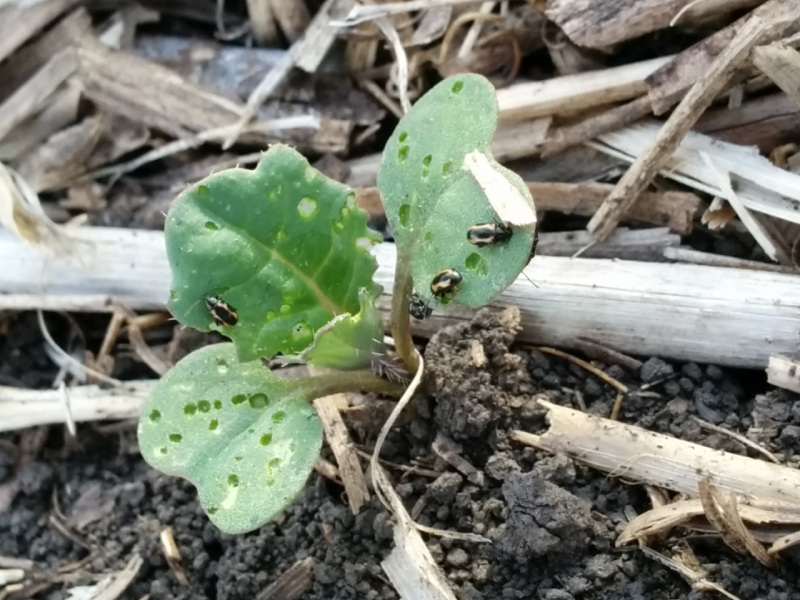Farm Life: Why Do Farmers Use Seed Treatments?
 My fourth generation farmer husband jokingly tweeted that we were going to be growing Cadbury Mini Eggs on the farm this year because our yellow peas were beautiful blue, pink, and purple pastel colors that also accompany the delicious chocolate candies. But wait a second—if we are growing yellow peas, then why are they blue, pink, and purple? Well, let me tell you why!
My fourth generation farmer husband jokingly tweeted that we were going to be growing Cadbury Mini Eggs on the farm this year because our yellow peas were beautiful blue, pink, and purple pastel colors that also accompany the delicious chocolate candies. But wait a second—if we are growing yellow peas, then why are they blue, pink, and purple? Well, let me tell you why!
What Are Seed Treatments?
Simply put, seed treating is the act of applying a product (pesticide) to the seed and there are a number of seed treatment types. Simon Ellis, a farmer and pedigreed seed grower from Manitoba, not only uses treated seed on his farm, but he has a seed business that sells and treats seed as well.
Pesticide seed treatments include fungicide or insecticide, or a combination of the two. Fungicides control diseases that affect seedling plants, and insecticides control insects like wire worms, flea beetles, or cutworms, that attack and eat seedling plants. They work to protect the seed two-fold: to control fungal pathogens on or in the seed and controlling fungal pathogens present in the soil. Most pesticide seed treatments last between 14 and 30 days. At this point the pesticide has broken down and is no longer controlling the pests.
Another type of treatment is for nutrients or fertilizers. They are less common, but if a crop responds to micronutrients like zinc, this is a good way to give the plant that nutrient. Bacteria treatments, known as inoculants, are another seed treatment that helps promote plant growth or stimulate nutrient development. Simon chooses to treat seed to help keep his crop healthy, disease free, and to produce the best quality food possible.
Seed treatment ensures that the crops get off to a good start and are not a new concept at all.

Why is the Seed Colored?
Pesticide seed treatments come in bright colors, so they can be easily identified and kept out of the food system for humans and the feed system for animals. The peas pictured above that our farm purchased from Stamp Seeds are colorful because they may have had a cereal (wheat, barley, etc.) treat which is usually red in their system prior to the pulse (peas, soybeans, etc.) treat which is usually blue and some mixing gives a purple color on the first few seeds, which was explained to me by Greg Stamp. PMRA (Pest Management Regulatory Agency) studies and will license seed pesticides if they are deemed safe and effective in Canada and the EPA does the same in the United States.
What are the Alternatives to Seed Treatment?
Seed treatments are used to protect the seeds from fungus and/or insects, so if seed treatments are not used it leaves a crop susceptible to disease and insects and the potential to use more foliar fungicides and insecticides (spraying above ground). I spoke with Gregory Sekulic, an agronomy specialist with the Canola Council of Canada, and he told me that insects consume about $300 million dollars’ worth of canola every year, and they don’t just go into a field and eat a very small amount of the yield, they destroy whole fields very quickly. His record for losing an entire crop is 36 hours. One morning the crop was healthy, with just a few beetle bites, but by

the next evening it was close to a disaster. I also spoke with an entomologist and they confirmed that for our region in Alberta that a good management plan for wireworms, flea beetles, and pea leaf weevils is seed treatment. It is essential, the best way to deal with them, and is a vital part of the production system.
Even with treatment, nearly one million acres of canola are sprayed with an insecticide for flea beetle, annually. Gregory explained that this is because when populations are high, the beetles will collectively eat a crop while dying from the seed treatment. If each beetle needs several bites of crop to ingest enough insecticide to be killed, imagine how many beetles are required to eat an entire field, despite the treatment!
The only reliable one is seed treatment, which is why all canola seed sold in Canada has a seed treatment. The fungicide is absolutely imperative.
Sarah Foster of 20/20 Seed Labs adds onto this by saying that alternatives would be to implement a robust crop rotation plan if not using a treatment. Also by making sure the seed has very strong germination and vigor, because seed is planted into cold soils in our growing region. She also agrees that treatment is an important part of good management practices.


